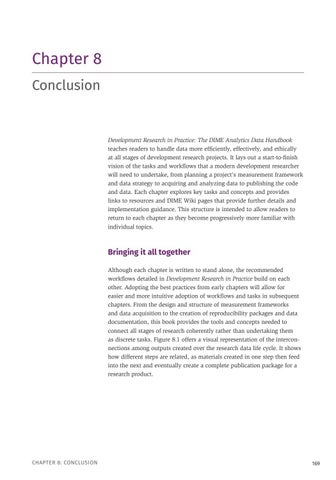Chapter 8 Conclusion
Development Research in Practice: The DIME Analytics Data Handbook teaches readers to handle data more efficiently, effectively, and ethically at all stages of development research projects. It lays out a start-to-finish vision of the tasks and workflows that a modern development researcher will need to undertake, from planning a project’s measurement framework and data strategy to acquiring and analyzing data to publishing the code and data. Each chapter explores key tasks and concepts and provides links to resources and DIME Wiki pages that provide further details and implementation guidance. This structure is intended to allow readers to return to each chapter as they become progressively more familiar with individual topics.
Bringing it all together Although each chapter is written to stand alone, the recommended workflows detailed in Development Research in Practice build on each other. Adopting the best practices from early chapters will allow for easier and more intuitive adoption of workflows and tasks in subsequent chapters. From the design and structure of measurement frameworks and data acquisition to the creation of reproducibility packages and data documentation, this book provides the tools and concepts needed to connect all stages of research coherently rather than undertaking them as discrete tasks. Figure 8.1 offers a visual representation of the interconnections among outputs created over the research data life cycle. It shows how different steps are related, as materials created in one step then feed into the next and eventually create a complete publication package for a research product.
CHAPTER 8: CONCLUSION
169





